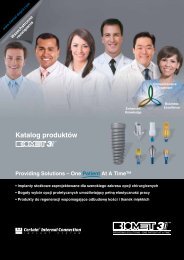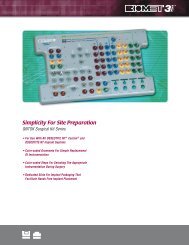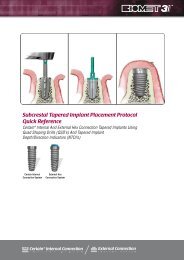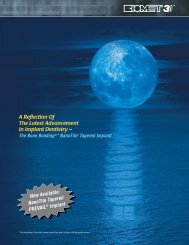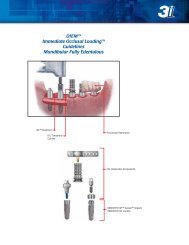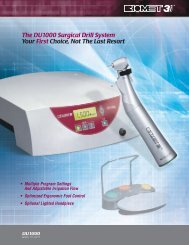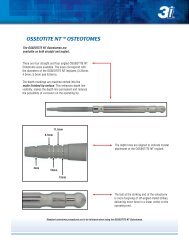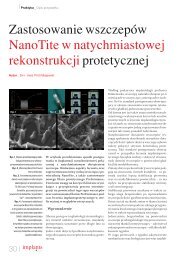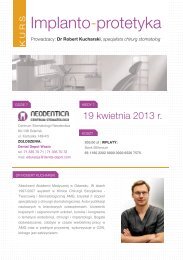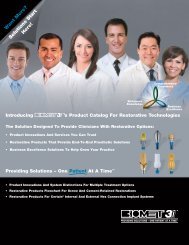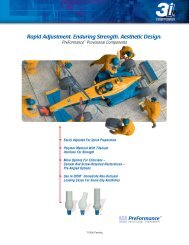SurgiGuide Cookbook - Dental-Depot
SurgiGuide Cookbook - Dental-Depot
SurgiGuide Cookbook - Dental-Depot
Create successful ePaper yourself
Turn your PDF publications into a flip-book with our unique Google optimized e-Paper software.
2. Positioning of the <strong>SurgiGuide</strong>Correct positioning of the <strong>SurgiGuide</strong> on the patient’s jawbone is essential in order toaccurately transfer the pre-operative treatment plan. This requires the <strong>SurgiGuide</strong> to fit on thejawbone in a unique and stable position.Taking time to fit the <strong>SurgiGuide</strong> accurately on the patient is extremely important. Verify thestability of the guide. Locate the accurate and stable position based on the unique fit thatcorresponds with the position of the <strong>SurgiGuide</strong> on the model.Do not exert excessive pressure on the guide. Minimizing the amount of pressure will preventthe guide from breaking.If you are not satisfied with the dimensions of the <strong>SurgiGuide</strong> (lingual or buccal extensions),you can easily adjust the shape of the <strong>SurgiGuide</strong>. Use caution, however. Altering the designof the <strong>SurgiGuide</strong> may affect the accuracy of the fit.If the bone contains a very sharp edge, it may be necessary to smooth the alveolar ridgeslightly to properly seat the guide on the bone.If for any reason, it is not possible to obtain a unique and stable fit, the accuracy of the guidecannot be guaranteed. As a result, the recommendation would be to not use the <strong>SurgiGuide</strong>and to revert to the standard surgical procedure.Reduction of the alveolar ridge.<strong>SurgiGuide</strong> are extremely beneficial when preparing an implant site on a sharp bony ridge. Amajor concern, the slipping of the drill, is prevented by the use of a <strong>SurgiGuide</strong>. The drillingcylinders guide the drill according to the planned drill path.If for any other reason, you need to do an alveolar ridge reduction, we advise the followingprocedure:– Ridge reduction after preparation of the implant site.Proceed with the above-indicated surgical protocol until you have used the last <strong>SurgiGuide</strong> inthe sequence. At this point, you can remove any excess of bone without compromising theuse and fit of the <strong>SurgiGuide</strong>.– Ridge reduction prior to preparation of the implant site.This is not recommended. Changes to the alveolar ridge can interfere with the fit and thus theaccuracy of the <strong>SurgiGuide</strong>.SURGICAL PROCEDURESIf you need to do a ridge reduction prior to drilling, indicating the planned ridgereduction on the <strong>SurgiGuide</strong> order form is recommended. This will allow us to provide alonger buccal or lingual extension (up to your preferences) of the <strong>SurgiGuide</strong>, though the fit ofthe <strong>SurgiGuide</strong> will not be guaranteed.Note that this is only possible with a limited ridge reduction (1 to 2 mm).3. First drillBased on the drilling sequence, a series of customized <strong>SurgiGuide</strong> are produced toaccommodate the specified diameters of each drill.For the first drill, begin with the <strong>SurgiGuide</strong> that contains the smallest stainless steel cylindersor fit the <strong>SurgiGuide</strong> with the correct drilling cylinders.Hold the guide down in the middle or on each of the two ends to prevent it from tilting orshifting. Maintain the guide’s position on the bone during the drilling process.57www.SimPlant.com<strong>SurgiGuide</strong> <strong>Cookbook</strong>



